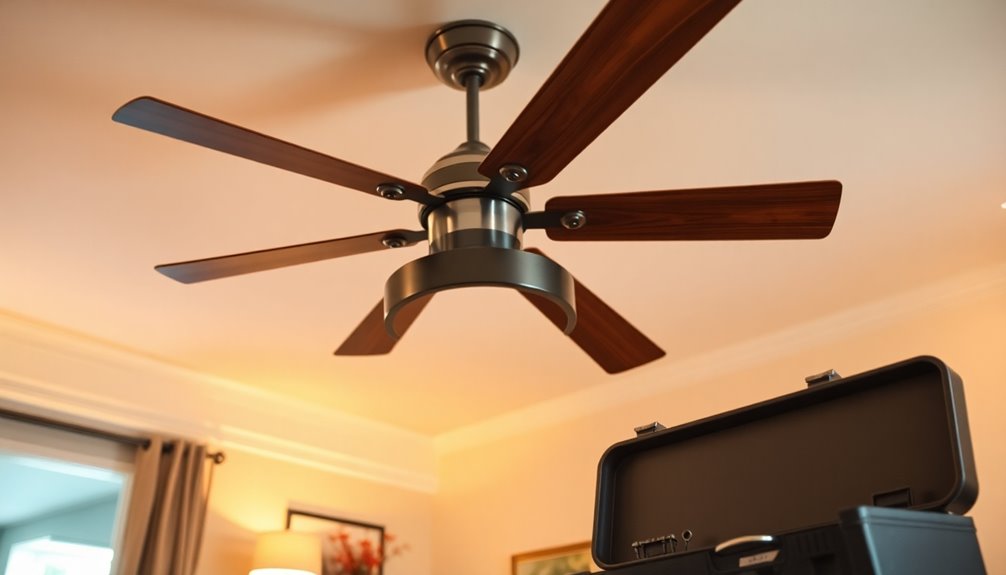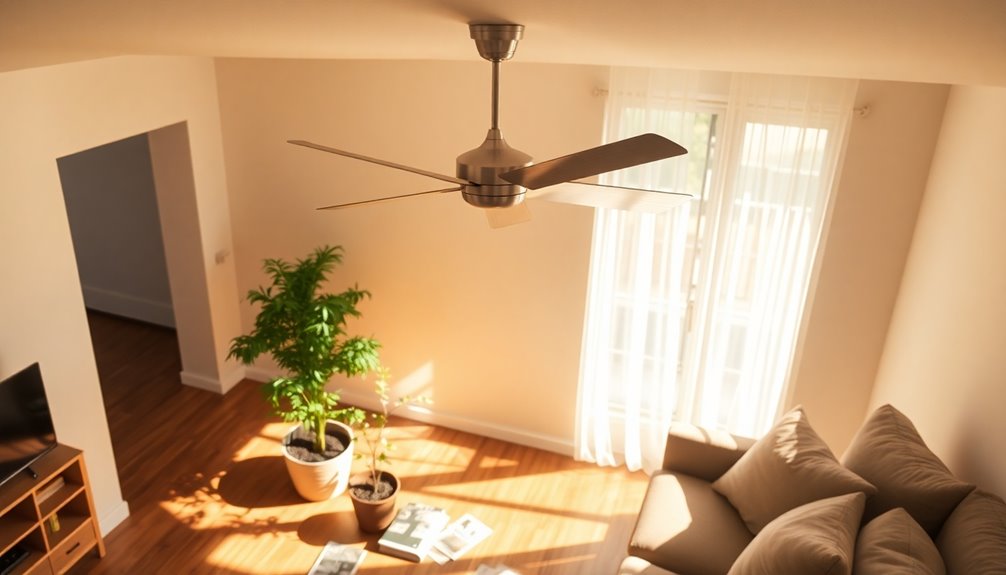Installing a ceiling fan usually costs between $144 and $353, with professional installation averaging around $248. If you're using existing wiring, you might spend between $100 and $500, but adding new wiring can push costs as high as $2,000. The type of fan you choose also impacts the price, with standard fans costing less than more complex models. Labor rates can range from $50 to $200 per hour, depending on your location. If you want to make an informed decision about your options, it's worth exploring all the factors that can influence your final costs.
Key Takeaways
- Average installation costs for ceiling fans range from $144 to $353, with professional services averaging around $248.
- Replacement costs vary based on wiring; it can be $100 to $500 for existing wiring and up to $2,000 for new wiring.
- Labor charges typically range from $50 to $200 per hour, depending on location and complexity of the installation.
- Additional features, like integrated light fixtures or remote controls, can increase installation costs by $100 to $300.
- Utilizing existing wiring and hiring a handyperson for simple installations can help reduce overall costs significantly.
Installation Cost Overview

When you're considering installing a ceiling fan, it's essential to break down the costs involved. The average cost to install a ceiling fan typically ranges from $144 to $353, with professional installation averaging around $248.
If you're looking to replace a ceiling fan, basic installations with existing wiring can cost between $100 and $500. However, if new wiring is needed, you could see costs soar to up to $2,000.
Installation costs can vary widely depending on the type of fan you choose. Standard and low-profile fans usually fall between $50 and $300, while more complex options like directional or rotational fans can range from $150 to $1,500.
Don't forget to factor in labor costs, as these can greatly affect your overall expenses. If you want additional features, such as built-in lighting, expect to add another $100 to $300 to your total. Remote control additions may set you back an extra $150 to $300.
Ultimately, your total ceiling fan installation costs can range from $657 to $1,103, including fan price, labor, and necessary materials.
Factors Influencing Installation Costs

Several factors can influence the overall installation costs of a ceiling fan. Understanding these elements can help you budget more effectively.
- Cost of labor: This typically ranges from $50 to $200 per hour, with urban areas generally charging more than rural locations.
- Installation complexity: If new wiring is needed, you might face costs up to $2,000. This can greatly impact your total cost.
- Accessibility of the ceiling area: Hard-to-reach spots may require extra labor, raising your project's price.
Additionally, the condition of your existing electrical wiring plays a vital role. If repairs or upgrades are necessary, expect to pay an additional $100 to $300.
The type of ceiling fan you choose also affects pricing, with options ranging from $50 to $800 based on design and features. Choosing a fan with high airflow capacity can enhance comfort while potentially requiring different installation considerations.
Whether you're hiring a licensed electrician or tackling the job yourself, keep these factors in mind to gauge your expenses accurately. By considering installation complexity, labor costs, and accessibility, you can plan for the total cost of installing your new ceiling fan more effectively.
Types of Ceiling Fans

When choosing a ceiling fan, you'll find various standard options that can enhance your space.
You might also want to take into account specialty features that offer unique benefits, like adjustable airflow or energy efficiency.
Understanding these types can help you select the right fan for your needs.
Standard Ceiling Fan Options
Considering a ceiling fan for your space? Standard ceiling fans are a fantastic choice for improving air circulation and enhancing the comfort of your home.
They're suitable for rooms up to 350 square feet and typically range from 52 to 56 inches for ideal performance.
Here are some key points to keep in mind when considering standard ceiling fans:
- Installation Costs: You can expect installation costs to range from $50 to $300, depending on the fan and any additional features.
- Light Fixtures: Many standard ceiling fans come with integrated light fixtures, which can add an extra $100 to $300 to your total installation costs.
- Wiring and Setup: Most installations can utilize existing wiring, making the process quicker and more affordable. Basic fan installation usually takes about 1-2 hours.
With standard ceiling fans, you're not just making a home improvement; you're also investing in comfort.
Whether you're looking to boost air circulation or add a stylish element to your decor, these fans offer a blend of functionality and aesthetic appeal.
Specialty Fan Features
Explore the variety of specialty ceiling fans available to enhance your home's comfort and style. Choosing the right type can transform your space while ensuring ideal airflow. Here's a quick overview of some popular options:
| Type of Fan | Price Range |
|---|---|
| Directional ceiling fans | $150 – $800 |
| Standard ceiling fans | $50 – $300 |
| Low-profile ceiling fans | $50 – $300 |
| Hanging propeller fans | $150 – $550 |
| Rotational fans | $200 – $1,500 |
Directional ceiling fans allow you to adjust airflow, making them ideal for targeted cooling. Standard ceiling fans are versatile and often come with integrated lighting. If you have low ceilings, low-profile ceiling fans are your best bet, while hanging propeller fans excel in larger rooms with high ceilings. For those seeking versatility, rotational fans with dual motors are worth considering, albeit at a higher cost. Investing in a new ceiling fan with specialty features can enhance both comfort and aesthetics in your home, especially when considering user-friendly installation options that can save you time and effort.
When you're planning installation, remember that the costs can vary greatly based on the fan type you choose. Investing in a new ceiling fan with specialty features can enhance both comfort and aesthetics in your home.
Labor Costs and DIY Options

Installing a ceiling fan can involve varying labor costs, so it's important to weigh your options. The decision between DIY vs. hiring a professional can greatly affect your budget. Here's a quick overview of what you might expect:
- Electricians typically charge around $150 for the first hour, with labor rates dropping to $50-$130 for subsequent hours.
- A handyperson can handle simple installations and may save you $50 to $200 compared to hiring a licensed electrician.
- For complex setups or new wiring, professional installation is highly recommended to guarantee safety and compliance with local electrical codes.
If you're considering a DIY approach, remember that ceiling fan installation costs can range from $100 to $275, including tools and the fan itself.
However, it requires a certain level of electrical knowledge to guarantee safety.
Ultimately, your choice will depend on your skill level and the complexity of the job. If you're not confident, investing in professional installation could save you time and potential headaches in the long run.
Additional Installation Costs

When you're planning to install a ceiling fan, additional installation costs can quickly add up.
Factors like wiring requirements, the type of fan you choose, and any extra features you want can all impact your overall expenses.
Understanding these elements helps you budget more effectively for your project.
Wiring Requirements Impact Costs
Wiring requirements play an essential role in determining the overall cost of installing a ceiling fan. If you have existing wiring, you may face lower installation costs, typically ranging from $100 to $300.
However, if new wiring is necessary, you could see your ceiling fan installation cost soar to between $250 and $700.
Here are some factors that can impact your installation costs:
- Upgrade electrical box: If your current electrical box isn't rated for ceiling fans, upgrading it may add $100 to $300 to your total cost.
- Complex installations: Installing multiple fans or doing additional electrical work can greatly increase installation labor and material costs.
- Outdoor ceiling fans: These installations can vary widely, costing anywhere from $70 to over $4,000, depending on the wiring requirements and location.
Ultimately, understanding these wiring requirements will help you budget appropriately for your ceiling fan installation.
Whether you go for a simple setup or opt for more complex installations, being aware of these additional installation costs guarantees you're prepared for the expense.
Type of Fan Matters
Choosing the right type of ceiling fan can greatly affect your installation costs. The type of fan matters because it directly influences the price range you'll encounter.
Standard fans generally cost between $50 and $300 to install, making them a popular choice. If you opt for low-profile fans, typically designed for ceilings under 8 feet, you can expect similar installation costs.
However, if you're considering rotational fans, be prepared for a much heftier price tag. Their installation can range from $200 to $1,500 due to their dual motor options and more complex design.
For rooms with ceilings over 9 feet, hanging propeller fans also come into play, with installation costs averaging between $150 and $550.
Directional fans are another option, but their installation costs can be steep, ranging from $150 to $800 due to their intricate design.
As you plan to install a ceiling fan, remember that any additional features you choose, like remote controls or built-in lighting, can also impact overall costs.
Additional Features Increase Price
Adding extra features to your ceiling fan can considerably bump up installation costs, especially if you're looking for enhanced functionality. If you're considering these additions, be prepared for the potential price hike:
- Built-in Light Fixture: This can add between $100 to $300 to your ceiling fan installation, depending on the complexity of the wiring involved.
- Remote Control: Installing a remote control typically increases your overall installation costs by $150 to $300.
- Switch Installation: If a new ceiling fan switch is necessary, you might incur additional expenses ranging from $100 to $200.
Moreover, complex installations that need new wiring—especially in areas lacking existing electrical connections—can drive total costs up to $2,000.
Outdoor ceiling fan installations can also vary dramatically in price, ranging from $70 to over $4,000 based on the fan type and installation conditions.
Ceiling Fan Accessories

Ceiling fan accessories can greatly enhance both the functionality and aesthetics of your installation. Investing in these items not only improves your fan's performance but also contributes to the overall look of your space.
For instance, angled ceiling mounts, typically costing between $20 and $50, are essential for guaranteeing proper alignment on sloped ceilings. This guarantees your fan operates efficiently, which can improve airflow efficiency throughout the room.
If you're tech-savvy, consider smart fan switch kits that range from $30 to $100. These allow you to control your fan via an app, promoting convenience and energy efficiency. Decorative pull chains, available for just $5 to $15, add a stylish touch and make it easy to operate your fan.
Keep in mind that if you plan to include additional wiring, especially for a fan and light combo, it can considerably increase your installation costs by $100 to $300, depending on the complexity of the setup.
Wiring Considerations

When it comes to wiring considerations for your ceiling fan installation, existing wiring can save you a significant amount of money—typically between $100 and $300.
However, if you need new wiring, be prepared for installation costs that can soar to as much as $2,000. Confirming compatibility between your existing wiring and the new ceiling fan is essential for safe and effective installation.
Here are a few key points to keep in mind:
- You may need a fan-rated junction box if your current ceiling box doesn't support fan installation.
- Professional installation is recommended for new wiring to comply with local electrical codes and guarantee safety.
- Complex installations may require additional electrical work, potentially increasing your overall budget.
If your existing wiring isn't compatible, you risk safety hazards and functionality issues. Additionally, ensuring your fan installation aligns with energy-efficient technology can further enhance performance and reduce costs.
Always consult a professional for complex installations and to verify everything meets electrical codes. Taking these wiring considerations into account can help you avoid costly mistakes and make certain your ceiling fan operates safely and effectively.
Saving Money on Installation

Many homeowners find that saving money on ceiling fan installation is easier than they think. One effective way to cut installation costs is by opting for ceiling fan replacement that utilizes existing wiring. This can keep your expenses between $100 and $300, rather than soaring to $2,000 for new wiring.
If you're considering multiple fans, installing them at the same time can further reduce overall costs by sharing travel fees and labor rates.
Timing your purchase can also lead to savings. Shop during off-peak seasons when ceiling fan prices often drop. Additionally, think about hiring a handyperson for simple installations instead of a licensed electrician. This could save you between $50 and $200 if you're using existing wiring.
Finally, choosing ENERGY STAR-rated ceiling fans not only helps you save money upfront on installation but also provides long-term savings on your utility bills. By making these savvy choices, you can enjoy your new fan while keeping your budget intact.
Hiring Professionals for Installation

Hiring a professional for ceiling fan installation can save you time and guarantee the job is done right. When you hire a ceiling fan installer, you're assuring that the installation meets all safety standards and local electrical codes. The cost for this service typically ranges from $100 to $300, depending on the complexity of the installation and your location.
Consider these key points when hiring an installer:
- Labor Rates: Expect to pay around $150 for the first hour, with additional hours costing between $50 to $130.
- Complex Installations: If you need additional wiring or have high ceilings, costs can escalate to as much as $2,000.
- Multiple Installations: Installing several fans at once can lead to savings on travel fees and labor.
Before you commit, ask about the installer's licensing, warranty on their work, and whether you'll need any additional wiring. This will help you avoid unexpected costs and assure your home is in good hands.
With a professional, you'll get peace of mind and a ceiling fan installation that's done correctly.
Frequently Asked Questions
How Much Does Labor Cost to Install a Ceiling Fan?
When you're looking at labor costs to install a ceiling fan, you'll typically find rates between $50 to $200 per hour.
Most electricians charge around $150 for the first hour, with additional hours costing $50 to $130.
For a basic installation, expect to pay between $100 to $500 in labor.
If you're considering DIY, keep in mind you might save some money, but it requires a solid understanding of electrical systems for safety.
How Much Does Lowes or Home Depot Charge to Install a Ceiling Fan?
If you're considering installation, Lowe's and Home Depot typically charge between $144 and $353 for ceiling fan setup.
Prices can fluctuate, especially if your fan features fancy lighting or if new wiring's needed.
Depending on the project's particulars, local labor costs can also play a part in the final price.
Do You Need an Electrician to Fit a Ceiling Fan?
You definitely need an electrician to fit a ceiling fan, especially if you're dealing with new wiring.
They'll guarantee everything meets local electrical codes and is safe for use. While some basic installations might seem simple, you don't want to risk safety issues or code violations by attempting it yourself.
Hiring a professional can save you time and provide peace of mind, knowing the job's done right and backed by a warranty.
Can the Average Person Install a Ceiling Fan?
Did you know that basic ceiling fan installations can typically be completed in just 1-2 hours?
If you've got some electrical knowledge, you can install a ceiling fan yourself. Make sure your ceiling box is rated for fan support, as that's essential for safety.
However, if you're unsure about any step, it's best to hire a licensed electrician to avoid potential hazards. A little caution can save you from costly mistakes down the line.
Conclusion
So, you've decided to install a ceiling fan, thinking it'll save you from sweating through the summer. Ironically, you might end up spending more than you planned! Between labor costs and unexpected accessories, your budget could fly right out the window. But don't worry; with a little planning and maybe some DIY spirit, you can still keep your cool—both literally and financially. Just remember, sometimes the simplest projects can turn out to be the most complicated!









